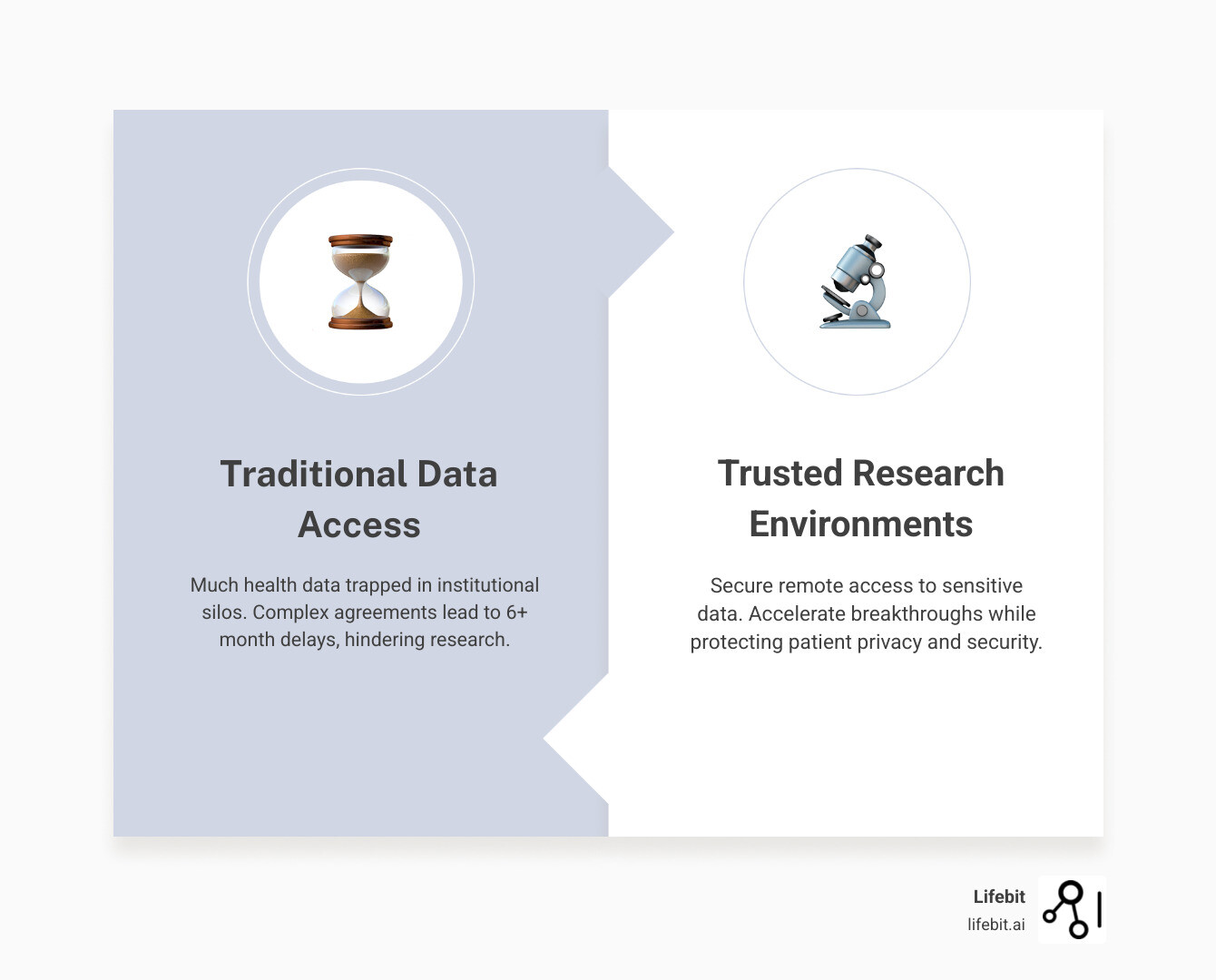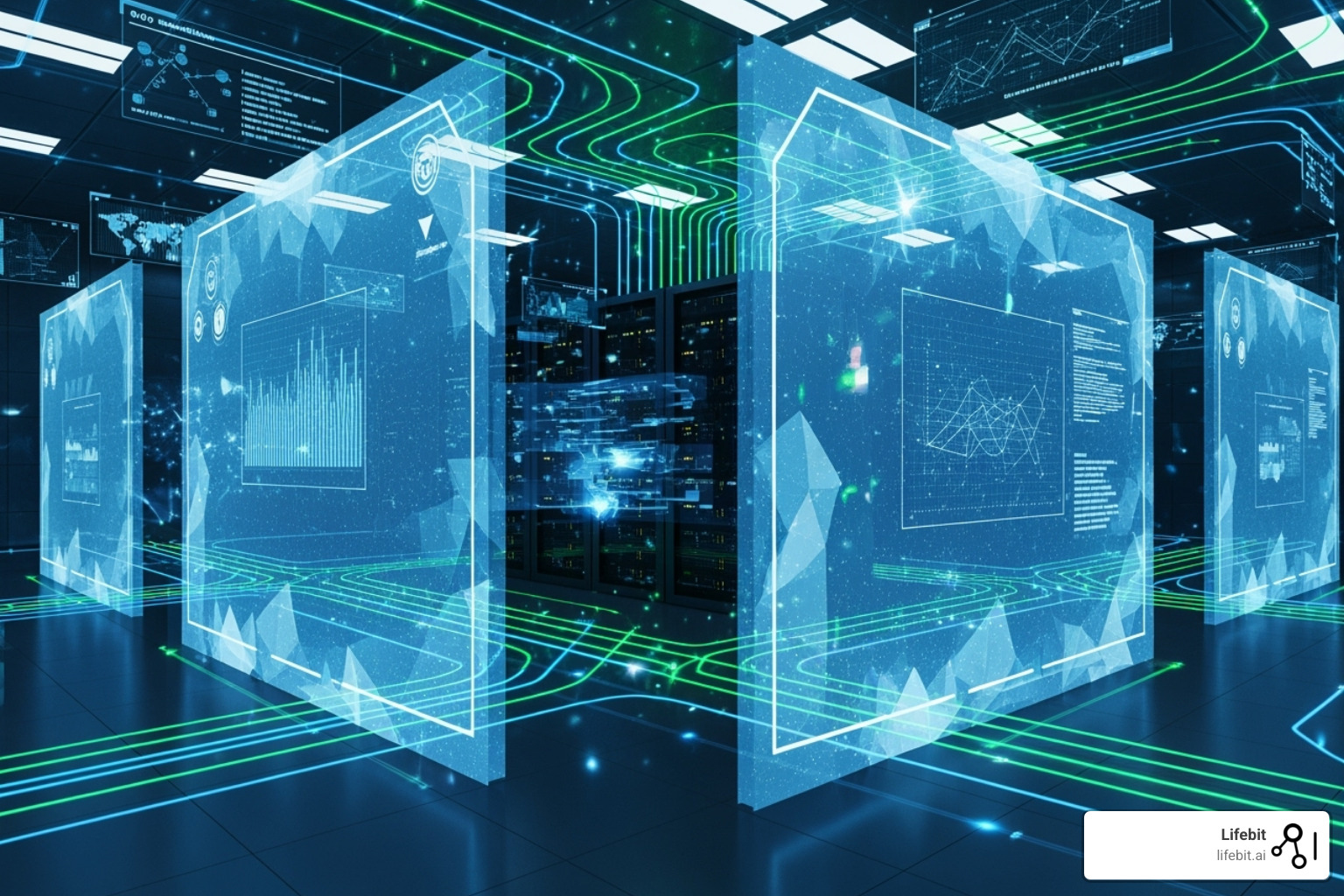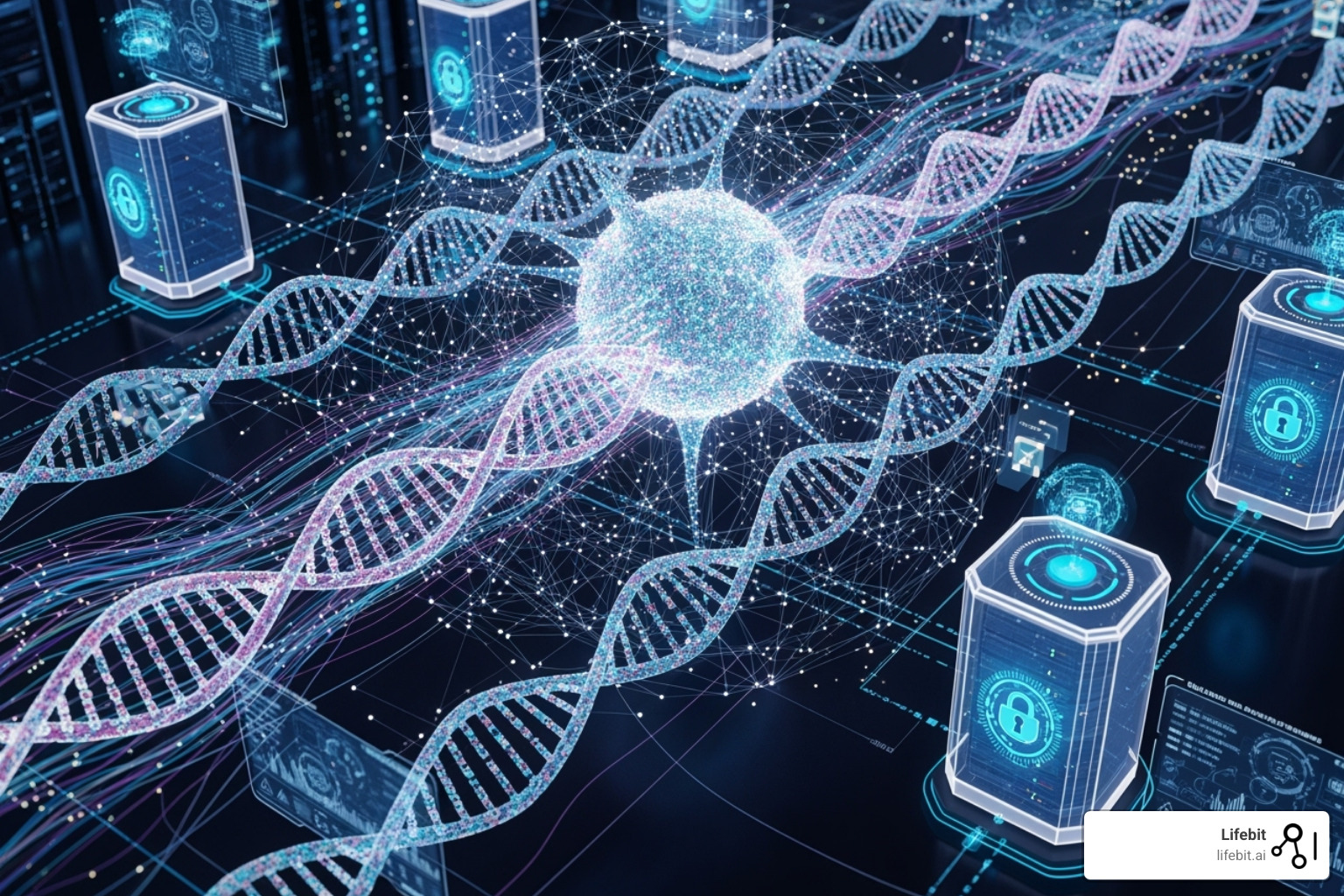Unlocking Data Secrets Safely with Trusted Research Environments

Why Trusted Research Environments Are Essential for Modern Data Science
Trusted research environments (TREs) are the cornerstone of secure data analysis in fields like healthcare and genomics. Also known as Data Safe Havens or Secure Data Environments, these highly secure computing platforms allow approved researchers to remotely access and analyze sensitive data, such as health records and genomic information, without it ever leaving the protective environment. This ensures patient privacy and data security remain intact.
Key Benefits:
- Enable groundbreaking research while protecting sensitive information
- Allow multiple researchers to collaborate on the same datasets securely
- Reduce data sharing delays from months to weeks
- Build public trust through transparent, ethical data use
The challenge is massive. A single whole genome requires 750MB of storage, and Genomics England alone houses over 135,000 whole genomes. Much of the world’s health data sits trapped in institutional silos, making it nearly impossible for researchers to access the comprehensive datasets needed for breakthrough findies. Complex data sharing agreements can take six months or longer for approval—a critical delay for patients awaiting new treatments. TREs provide a secure bridge between data protection and scientific progress.
As CEO and Co-founder of Lifebit, I have over 15 years of experience at the intersection of genomics, AI, and secure data platforms. My work has focused on building trusted research environments that power data-driven findy across compliant, federated systems, demonstrating how the right infrastructure can open up unprecedented scientific collaboration while upholding the highest security standards.

What is a Trusted Research Environment?
A Trusted Research Environment (TRE) is a highly secure computing environment where approved researchers can remotely analyze sensitive data without ever moving it outside its protective walls. Think of it as a secure reference library: researchers bring their questions to the data, not the other way around. The data never leaves, which is what makes these platforms—also known as Data Safe Havens or Data Clean Rooms—so trustworthy. This controlled access model gives researchers the tools they need while data custodians maintain complete oversight. For a deeper dive, see our explanation: What is a Trusted Research Environment?
The Critical Need in the Age of Big Data
The scale of modern health data is staggering. A single whole genome requires 750MB of storage, and biobanks like Genomics England house over 135,000 genomes. Combined with electronic health records (EHRs), these massive datasets hold the potential for transformative medical cures. However, much of this data is locked in institutional silos. Researchers face complex data sharing agreements that can drag on for six months or longer, a critical delay when developing new treatments. This inefficiency has slowed the realization of health data’s full potential, making TREs a vital solution.
Core Benefits for Science and Society

TREs provide significant benefits for all stakeholders:
-
For researchers: TREs accelerate research by replacing months-long data access negotiations with a secure, collaborative workspace. This enables deeper insights and more comprehensive studies. Learn how we are Accelerating Disease Research with Trusted Research Environments.
-
For data custodians: Hospitals, biobanks, and government agencies gain unparalleled control and security. Knowing their sensitive data never leaves the protected environment simplifies compliance with regulations like GDPR and HIPAA.
-
For the public: Ethical and secure data use builds public trust, which is crucial for participation in research. TREs also improve cost-effectiveness by reducing duplicated infrastructure, directing more funding toward findies.
The Five Safes: A Blueprint for Building Trust and Security
The Five Safes framework, originally developed by the UK Office for National Statistics, is the internationally recognized gold standard for governing secure data access. It provides a holistic, multi-layered risk management approach by considering five key elements: safe people, safe projects, safe settings, safe data, and safe outputs. Rather than relying on a single point of failure, this model ensures that each component contributes to a robust digital fortress protecting sensitive health information. This framework is not merely a checklist but a comprehensive philosophy for building and maintaining trust. Learn more about the Five Safes Framework.
Safe People
The human element is often the weakest link in any security chain, making researcher trustworthiness a critical control point. TREs address this by implementing rigorous vetting and accreditation processes. This goes beyond simple identity verification and includes background checks, professional references, and mandatory, role-specific training. This training covers information governance, data protection principles (like GDPR), statistical disclosure control, and the specific security protocols of the TRE. Researchers must often pass an exam to become an “Accredited Researcher,” a status that can be revoked for non-compliance. This creates a culture of accountability and professional responsibility. Statistics show that 79% of interviewed TREs require researchers to sign legally binding agreements with clear penalties for data misuse, 85% mandate specialized training, and 76% limit access to individuals affiliated with approved institutions, which adds an additional layer of organizational oversight.
Safe Projects
To ensure data is used ethically and for its intended purpose, every project undergoes a stringent approval process. This is typically managed by a Data Access Committee (DAC) or an equivalent independent review body. These committees are multidisciplinary, often including scientists, ethicists, legal experts, and, crucially, patient and public representatives. Research proposals must demonstrate clear and significant public benefit, aligning with the consent given by data donors. The project’s scope must be well-defined, and access is granted on a project-specific basis under the principle of data minimization. This means researchers are only granted access to the specific data variables and time periods essential for their approved study. The principle of proportionality is also applied: the potential public benefit of the research must outweigh the residual privacy risks. Many TREs now publish project approvals and summaries to improve public transparency and trust in their operations.
Safe Settings

This refers to the secure technological environment where data analysis occurs. The core principle is that data never leaves the environment. This is enforced through a combination of technical controls that create a secure “walled garden.” Key security measures include:
- Secure Access: Multi-factor authentication (MFA) and role-based access controls (RBAC) ensure only authorized users can gain entry and only access tools and data relevant to their project.
- Network Isolation: Internet access from within the TRE is typically blocked or heavily restricted to prevent data exfiltration. Any necessary software packages are pre-vetted and installed by administrators.
- End-to-end Encryption: Data is encrypted both in transit (as it moves within the system) and at rest (while in storage), rendering it unreadable if intercepted.
- Continuous Auditing and Monitoring: Every action, from login attempts to commands executed, is logged and monitored in real-time to detect and respond to suspicious activity. This creates a complete audit trail for accountability.
- Robust Infrastructure: The environment is built on secure infrastructure, often compliant with international standards like ISO 27001 and SOC 2, and includes comprehensive incident response and disaster recovery plans to ensure data integrity and availability.
Safe Data
This principle focuses on protecting individual privacy by minimizing the risk of re-identification within the datasets provided to researchers. Several techniques are used, often in combination:
- De-identification: Direct identifiers like names, addresses, and full dates of birth are removed.
- Pseudonymisation: Direct identifiers are replaced with artificial ones (pseudonyms). A trusted third party, separate from the researchers and the TRE operators, holds the key linking the pseudonym back to the real identity. This allows datasets to be linked over time without revealing a person’s identity to the analyst.
- Anonymisation: Statistical methods are applied to permanently prevent re-identification, for example by grouping data into broader categories (e.g., age bands instead of specific ages). This is often guided by principles like k-anonymity, which ensures each individual in the dataset is indistinguishable from at least ‘k-1’ other individuals.
Even with these protections, the risk of “triangulation attacks”—where an attacker combines a de-identified dataset with other publicly available information to re-identify individuals—remains. This is why Safe Data is just one of the five essential safeguards.
Safe Outputs
The final safeguard ensures that research results do not inadvertently disclose sensitive information. Before any output (e.g., a table, graph, or statistical model) can be exported from the TRE, it undergoes a rigorous disclosure control review. This is a critical “airlock” process, typically performed by trained human experts. Currently, 0% of interviewed TRE operators believe software can fully replace human checks for this nuanced task. Reviewers check for common risks, such as small cell counts in tables (e.g., any cell representing fewer than 5 or 10 individuals is suppressed). The review process is becoming more complex with the rise of AI. For example, an AI model itself could be a disclosure risk through “membership inference attacks,” where an attacker could determine if a specific individual’s data was used to train the model. While 100% of interviewed TREs allow export of aggregate-level data, more complex outputs like AI models (23% allowed) or source code (74% allowed) require extreme caution and specialized review protocols due to the risk of embedded data or reverse-engineering.
How Trusted Research Environments Work: From Ingestion to Insight
Understanding the operational workflow of a TRE reveals how it effectively balances the demands of cutting-edge science with the non-negotiable requirement for data security. A series of sophisticated technical and procedural controls are applied to protect data throughout its entire lifecycle, from its arrival in the environment to the final export of research findings.
The Data Lifecycle within a TRE

The data journey follows several carefully secured steps:
- Secure Data Ingestion: Data custodians do not simply upload data. They use highly encrypted channels, such as Secure File Transfer Protocol (SFTP) or dedicated APIs with end-to-end encryption, to transfer datasets into a secure landing zone within the TRE. Upon arrival, data is quarantined and validated to ensure its integrity and check for malware before it is moved into the main processing area.
- Secure Storage and Processing: Inside the TRE, raw data undergoes change. It is pseudonymized, cleaned, and harmonized. Harmonization is a critical step where data from different sources is mapped to a common data model (like the OMOP Common Data Model) so it can be analyzed consistently. During this phase, different datasets (e.g., genomic, clinical, and imaging data) are linked using the secure pseudonyms, creating richer, multi-modal views for analysis without exposing personal identities.
- Controlled Analysis: Approved researchers access a virtual desktop environment within the TRE. Here, they find a suite of pre-installed and vetted analysis tools, such as RStudio, Python with scientific libraries, and specialized bioinformatics pipelines. They have access to powerful computing resources but are in a “walled garden”: they cannot download raw data, and external internet access is blocked to prevent data leakage. The data stays put; only the researcher’s analytical queries interact with it.
- Controlled Output and Airlock: No result can leave the TRE without explicit approval. When a researcher has a result (e.g., a summary table or a graph), they submit it for review through a formal “airlock” process. This triggers a workflow for a trained Statistical Disclosure Control (SDC) expert to examine the output. The expert checks for any potentially disclosive information, such as small cell counts. If the output passes, it is released to the researcher. If it fails, it is returned with feedback for revision.
Critical Security Components of a trusted research environment
A TRE’s security is not a single feature but a defense-in-depth strategy built on several interconnected layers:
- Role-based access control (RBAC): This ensures users operate under the principle of least privilege. A Data Manager may have permissions to ingest and curate data, while a Researcher can only analyze the specific dataset approved for their project, and an Auditor may have read-only access to logs.
- Multi-factor authentication (MFA): This adds a critical layer of login security beyond a password, requiring a second verification step (e.g., a code from a mobile app), making unauthorized access significantly more difficult.
- End-to-end encryption: This protects data at all stages: at rest (in databases and storage), in transit (moving across the network), and increasingly, in use (using confidential computing technologies).
- Continuous auditing and monitoring: Every action within the TRE is logged and analyzed in real-time. This includes every command typed, file accessed, and network connection attempted. Automated alerts flag unusual patterns or potential threats for immediate investigation by a security team.
- Incident response and disaster recovery: TREs have pre-planned and regularly tested procedures to ensure business continuity and data integrity. This includes tabletop exercises for security events and robust backup and recovery systems to handle system failures.
Evolving Architectures: Centralised vs. Federated Models
TRE architecture is evolving to meet the challenges of global collaboration and data sovereignty.
-
Centralised TREs: In the traditional model, data from various sources is physically moved and copied to a single, central location for analysis. While this simplifies governance and standardisation, it can be costly, time-consuming, and challenging for massive datasets. It also raises data sovereignty concerns, as organizations may be legally or politically unable to move data outside their jurisdiction.
-
Federated Model: This game-changing approach keeps data in its original, secure location. Instead of moving data to the analysis tools, the analysis query is securely sent to the data. Each participating institution maintains its own secure environment (a “node” in the federation), and the federated system orchestrates the analysis across these nodes, returning only aggregated results. This is the core of Federated Data Analysis.
The benefits of federation are transformative: it improves security by eliminating risky data transfers, respects data sovereignty by giving custodians full control, and offers limitless scalability. This approach, supported by emerging standards from groups like the Global Alliance for Genomics and Health (GA4GH), is revolutionizing global research collaboration, as demonstrated by our Federated Trusted Research Environment, which enables analysis of distributed datasets while maintaining the highest security standards.
Real-World Impact and Governance of Trusted Research Environments
Trusted research environments are not just a theoretical concept; they are actively accelerating medical research and generating real-world impact today. This success is built on a dual foundation of powerful technology and robust governance frameworks that prioritize transparency, ethics, and public trust.
Success Stories in Health Research
The impact of TREs is evident in the scale and speed of research they enable. The UK’s Secure Research Service, a leading TRE, supports over 600 research projects at any given time. One standout example is a population-based cohort study of 46 million adults in England conducted within the NHS Digital TRE. This study, which analyzed risks of blood clots after COVID-19 infection and vaccination, was conducted on a scale that would be impossible with traditional data sharing methods. Similarly, Scotland’s National Safe Haven has dramatically accelerated access to critical health datasets, proving invaluable for rapid COVID-19 research on vaccine effectiveness and long COVID.
Internationally, Genomics England has leveraged its TRE to provide secure access to the data from its 100,000 Genomes Project, leading to new diagnoses for patients with rare diseases and insights into the genetic basis of cancer. These national Safe Haven models demonstrate how to balance research accessibility with stringent protection, creating a proven template for other nations to follow. The insights generated are not minor; they directly inform clinical practice, public health policy, and the development of new therapies.
Governance, Oversight, and Public Trust
Effective governance is as critical as the technology itself. A TRE cannot succeed without earning and maintaining public trust, a concept often referred to as a “social license to operate.” This was a key finding of the independent review by Prof Ben Goldacre for the UK government, which emphasized that TREs are the default mechanism for advancing research while maintaining privacy.
Building this trust requires several key components:
- Public Engagement and Involvement: The most successful TREs embed Patient and Public Involvement and Engagement (PPIE) into their governance. This means that patients and members of the public are not just consulted; they are active members of oversight committees and decision-making bodies. They help shape data access policies, review research proposals for public benefit, and ensure communication is clear and transparent. There are many examples demonstrating how public contributors have directly shaped TRE operations.
- Legal and Ethical Frameworks: TREs operate within strict legal boundaries, such as GDPR in Europe and HIPAA in the US. Governance frameworks must clearly define the lawful basis for data processing and ensure all research adheres to the consent provided by participants. Independent ethics committees often provide an additional layer of oversight for particularly sensitive research projects.
- Radical Transparency: Trust is built on openness. This includes publishing registers of all approved data users and projects, along with lay summaries of the research and its outcomes. Regular transparency reports detailing data usage, security measures, and any breaches are essential. This collaborative approach makes the public partners in research, not just data sources, ensuring the long-term sustainability and success of TREs.
The Future of Research: Challenges and Next-Generation TREs
While transformative, trusted research environments are not a final solution. They face ongoing challenges and must continuously evolve to meet the complex and escalating demands of modern genomics, artificial intelligence, and global collaborative research.
Current Challenges and Limitations
Despite their successes, first-generation TREs grapple with several key problems:
- Data Access Delays: The rigorous, often manual, approval processes can still take six months or more. These delays, caused by legal reviews, ethics committee schedules, and administrative backlogs, can critically slow down time-sensitive research, such as during a pandemic.
- Scalability and Cost: Nearly half of interviewed TREs (45%) struggle to scale their computing and storage infrastructure to handle the petabyte-scale datasets now common in research (the UK Biobank alone is over 20 petabytes). The cost of maintaining and scaling these centralized systems can be prohibitive.
- Interoperability: The proliferation of different TREs has created new, highly secure silos. A lack of common technical and governance standards makes it difficult for researchers to conduct studies across multiple TREs, limiting the statistical power and diversity of research.
- Supporting Advanced Analytics: The very security that makes TREs safe can complicate the use of cutting-edge AI/ML tools, which may require specific software dependencies or internet access for pre-trained models. AI model export is a major challenge, with only 23% of TREs currently permitting it due to the risk of the model itself containing sensitive data.
- Reliance on Human Checks: The manual review of all outputs is resource-intensive and creates a significant bottleneck. Notably, 0% of TRE operators believe software can currently replace human reviewers for this critical task, highlighting a major barrier to scaling up research throughput.
Meeting the Needs of AI and Genomic Research

The future of research requires more agile, scalable, and interconnected TREs. The next generation of these platforms is being designed to support the entire AI lifecycle and leverage new technologies to improve privacy.
-
Privacy-Enhancing Technologies (PETs): PETs are becoming key enablers, allowing for more advanced analysis while mathematically guaranteeing privacy. Key examples include:
- Federated Learning: A specific type of federated analysis where an AI model is trained across multiple decentralized datasets without the data ever being moved or pooled.
- Homomorphic Encryption: Allows computations to be performed directly on encrypted data. While still computationally intensive, it holds the promise of “zero-trust” analysis.
- Secure Multi-Party Computation (SMPC): Enables multiple parties to jointly compute a function over their private inputs without revealing those inputs to each other.
- Differential Privacy: Involves adding carefully calibrated statistical noise to query results to make it impossible to determine whether any single individual was part of the dataset.
- Synthetic Data: Generating artificial datasets that retain the statistical properties of the real data but contain no real patient information, useful for training models and testing code.
-
Federated TRE Ecosystems: The most significant evolution is the shift from monolithic TREs to federated ecosystems. These systems, driven by policy initiatives like the European Health Data Space (EHDS), allow data to remain with its custodians while enabling powerful, distributed computations. This federated model directly addresses the challenges of data sovereignty, scalability, and interoperability, opening the door to secure, global research collaboration. This is central to initiatives like Building European Trusted Research Environments, enabling cross-border research without compromising security.
Conclusion
Trusted research environments are the essential bridge between groundbreaking scientific findy and the data privacy that patients and the public deserve. They provide a secure framework, guided by principles like the Five Safes, to open up insights from massive health datasets while keeping sensitive information protected.
The field is rapidly evolving from centralized models to federated architectures, where analysis is brought to the data. This shift, combined with emerging privacy-enhancing technologies, is preparing TREs for the next generation of AI-driven and genomic research. While challenges like access delays and output bottlenecks remain, the real-world impact is undeniable, with TREs already powering population-scale studies that are changing our understanding of health and disease.
At Lifebit, we are at the forefront of this evolution. Our next-generation federated platform provides secure, real-time access to global biomedical data. By integrating advanced AI/ML analytics and federated governance, we power large-scale, compliant research for biopharma, governments, and public health agencies. Our goal is to enable life-saving research while maintaining the public trust that makes it possible. Find how we are shaping the future with the Lifebit Trusted Research Environment.


One thought on “Unlocking Data Secrets Safely with Trusted Research Environments”
Comments are closed.